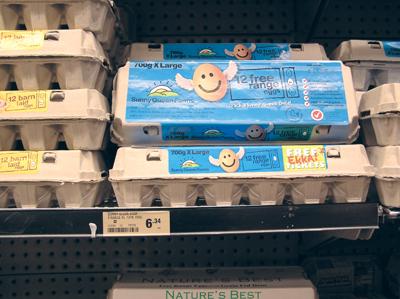
PIC Update: What’s New in Poultry Welfare?
By PIC
Features New Technology ProductionWhat welfare experts had to say at the PIC’s Research Day
The welfare of the birds was approached from every angle at our annual
PIC Research Day on May 11. Poultry welfare specialists from academia,
industry and government spoke about the latest research, poultry care
programs, and welfare assurance schemes.
By Kimberly Sheppard, Research Co-ordinator
The welfare of the birds was approached from every angle at our annual PIC Research Day on May 11. Poultry welfare specialists from academia, industry and government spoke about the latest research, poultry care programs, and welfare assurance schemes.
 |
|
| Public Concerns Speaker Dr. Tina Widowski said at PIC’s Research Day that it’s important to regularly monitor public attitudes about poultry welfare. The poultry industries must respond to public concerns by providing choice in the marketplace and information to consumers about welfare assurance. |
With welfare-driven legislative changes in Europe, and laws being instated closer to home (think Proposition 2 in California), we wanted to hold this day to ensure that you, the producer, are educated about what exactly is going on out there, and are prepared for changing times ahead.
The day was kicked off by Dr. Tina Widowski, professor and director of the Campbell Centre for the Study of Animal Welfare at U of G. She gave the keynote lecture on consumer/citizen duality and its relationship to welfare-related decision making within the poultry industry. We often hear the needs and wants of “the consumer” referred to within marketing discussions – but who is this ”consumer”?
Widowski pointed out that people respond to surveys and engage in community behaviour (such as signing petitions or voting) concerning farm animal welfare not as consumers, but as good “citizens” who would “do the right thing.” However, when making purchasing decisions those same people become “consumers” and instead think about a variety of product attributes, including perceived food safety, taste and quality, personal health concerns and cost. Widowski says it is important to regularly monitor public attitudes about poultry welfare, and for the poultry industries to respond to public concerns by providing choice in the marketplace and information to consumers about welfare assurance.
A real-world welfare assurance scheme, called Global Animal Partnership (or GAP) was outlined by Dr. Ian Duncan professor emeritus at Guelph. This scheme – essentially a labelling program – has been instituted by Whole Foods and will be adopted by other grocery chains in June. The program is a five-level step-up program. Participating farmers can enter the program at “Level 1,” which allows for no cages and no crowding. At each step, additional welfare safeguards are added. Whole Foods now has participating producers in the U.S. and labels can be seen on products in their stores.
Jen Gardner has spent the last five years working on the development of the Chicken Farmers of Canada Animal Care Program (ACP), the first audits of which are underway. She says animal care has always been a priority for CFC and that through the Canadian Poultry Research Council, CFC has supported poultry welfare research and establishment of a virtual centre for poultry welfare research in Canada (stationed in Guelph). CFC felt that a formal Animal Care Program was necessary as the Codes of Practice are voluntary with no enforcement mechanism. The new ACP covers such areas as feed and water, environment, stocking density, bird monitoring and handling, health-care practices and catching/loading. The program is auditable and is intended to be the one and only national standard for chicken in Canada.
Some of the ways in which animal welfare is assessed in practice were covered by Penny Lawlis, Humane Standards Officer with OMAFRA. She described measures including “engineering standards” (specific standards for housing, etc.), “management-based standards” (documentation of policies, procedures, staff training, etc.), and “animal-based standards” (measures of animal responses and reactions). She described how United Egg Producers, who represent the majority of egg farmers in the U.S, and the European Union Welfare Quality Project are incorporating some of these measures into their certification programs. In the EU, standards for on-farm welfare assessment and information systems have been based upon consumer demands, the marketing requirements of retailers, and on stringent scientific validation.
Some of the science behind animal welfare assurance decisions was described by Dr. Hank Classen (University of Saskatchewan). He talked about beak anatomy and the physiological effects of beak-trimming in laying hens. He showed that the beak is rich with nerves and is important for the sense of touch, and said that beak trimming can compromise welfare if not performed properly. However, it is currently necessary to prevent cannibalism, reduce feed wastage and improve feed efficiency. Classen said that the type of beak trimming can impact welfare, with infra-red trimming having advantages over hot-blade trimming.
Dr. Classen also spoke about research on broiler lighting. Research shows that, in comparison to a 23 hours daylength, providing a longer dark period is better for bird health and welfare, with six to eight hours of continuous daylength being desirable. Overall, he said that providing at least four hours of darkness is required to improve bird welfare.
Dr. Bill Muir, geneticist at Purdue University, outlined his research program on using a genetic approach to improve animal welfare. He showed that individual selection of laying hens for high production has inadvertently resulted in selection for more aggressive birds (feather-peckers). He has been working on “group-selection” in which breeders are selected based on the best-performing group rather than the best-performing individual. Within six generations, it is possible to breed birds that need no break trimming and can be housed together relatively peacefully while maintaining very high production levels. To look at any of these talks in depth, visit the PIC website (www.poultryindustrycouncil.ca). We have both the program (slide presentations) and a video of the talks available.
Print this page